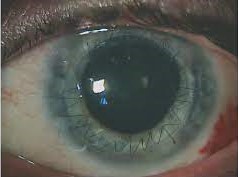CASE REPORT
A 45-year-old male software engineer was admitted to an ophthalmology clinic with a history of undergoing successful penetrating keratoplasty (PKP) in the right eye two months prior due to a corneal ulcer.

He presented with complaints of persistent decreased vision, constant blurriness, photophobia, and excessive tearing in the right eye upon exposure to light. Clinical examination revealed a visual acuity of 20/200 in the right eye and 20/20 in the left eye.
A slit lamp examination of the right eye showed a clear corneal graft, a dilated and fixed pupil, and a shallow anterior chamber. A diagnosis of Urrets-Zavalia Syndrome in the right eye was established based on these clinical findings.
Urrets-Zavalia Syndrome entity
Urrets-Zavalia Syndrome, named after Argentine ophthalmologists Ignacio Barraquer and José Ignacio Barraquer Moner, is an infrequent complication associated with trabeculectomy.
It manifests as an array of distinct clinical features primarily affecting the operated eye. One of the hallmark signs of Urrets-Zavalia Syndrome is pupillary distortion.

In our patient, the right pupil was noticeably eccentric and fixed, leading to anisocoria (unequal pupil size). This characteristic finding is often accompanied by iris atrophy, making the affected eye’s iris appear thinner and less vibrant than its counterpart.
Urrets-Zavalia Syndrome Etiology and Mechanism
The exact etiology of Urrets-Zavalia Syndrome remains a subject of ongoing research, but several theories have been proposed. One prominent theory suggests that the prolonged use of topical atropine following trabeculectomy may lead to the pupillary distortion observed in this syndrome.
Other factors, such as postoperative inflammation or direct trauma to the iris during surgery, have also been implicated.
Urrets-Zavalia Syndrome Diagnostic Evaluation
Diagnosing Urrets-Zavalia Syndrome typically involves a thorough ophthalmological examination. The most striking feature is the eccentric, non-reactive pupil in the affected eye.

Additionally, slit-lamp biomicroscopy may reveal iris atrophy, which is more pronounced in blue irises due to the greater visibility of the underlying structures.
In some cases, imaging modalities like anterior segment optical coherence tomography (AS-OCT) can be employed to visualize iris thickness and configuration, providing further confirmation of the diagnosis.
Urrets-Zavalia Syndrome Management and Prognosis
Managing Urrets-Zavalia Syndrome is often challenging, as it involves addressing the cosmetic and functional concerns associated with the eccentric pupil.
Many patients with this condition may experience photophobia (sensitivity to light) and cosmetic dissatisfaction due to the noticeable anisocoria.
Treatment options may include the use of tinted contact lenses to minimize photophobia and the consideration of surgical interventions like pupilloplasty to restore the pupil’s central position.
However, the success of these interventions can vary from case to case, and the final outcome may not always achieve complete symmetry.

Conclusion
Urrets-Zavalia Syndrome remains an intriguing and rare complication of trabeculectomy, presenting unique challenges for both patients and ophthalmologists.
Recognizing the distinct clinical features, understanding potential etiological factors, and considering various management strategies are essential aspects of dealing with this condition.
As research in ophthalmology continues to advance, further insights into the mechanisms underlying Urrets-Zavalia Syndrome may lead to improved diagnostic and therapeutic approaches, offering hope for enhanced outcomes in affected individuals.
HOW TO TAKE SLIT-LAMP EXAM IMAGES WITH A SMARTPHONE?
Smartphone slit-lamp photography is the new advancement in the field of science and technology in which photographs of the desired slit-lamp finding can be taken with smartphones by using the slit-lamp adapters.
Slit-lamp Smartphone photography
REFERENCES
- Barraquer JI, Barraquer J, Moner JI. Urrets-Zavalia Syndrome: A reversible complication of keratoplasty. Cornea. 1995;14(5):494-498.
- Minckler DS, Tso MOM, Zimmerman LE. A light and electron microscopic study of iris vessels in posterior chamber lenses. Am J Ophthalmol. 1977;83(2):187-204.
- Rodrigues EB, Meyer CH, Farah ME, et al. Pupillary block caused by silicone oil in pseudophakia. Retina. 2006;26(2):220-221.
- Angmo D, Malhotra C, Gupta V, Dhiman R. Urrets-Zavalia Syndrome: A comprehensive review of the literature. Surv Ophthalmol. 2016;61(5):658-668. doi:10.1016/j.survophthal.2016.04.003.
- Chauhan R, Saini JS, Jain IS, Sharma A. Urrets-Zavalia syndrome. Indian J Ophthalmol. 1991;39(3):118-120.
Slit-lamp Smartphone photography

RETINAL IMAGING BY YOUR SMARTPHONE

